This document discusses applying new media tools like blogs and social media in primary school classrooms. It summarizes a case study of a school blog run collaboratively by a teacher, students, and parents over two years. Surveys of parents and focus groups with students found that the blog had positive impacts. It engaged students and parents in media literacy activities and diffusion of alternative media patterns. However, teachers need proper training to effectively integrate new media into teaching and develop students' digital literacy skills. The emergence of Web 2.0 requires new approaches to learning that are collaborative, learner-centered, and personalized.
![APPLYING NEW MEDIA IN THE CLASSROOM:
A BLOGGING PARADIGMFOR THE PROJECTION & DIFFUSION
OF ALTERNATIVE MEDIA & CULTURAL PATTERNS*
Dr. Elisavet Deliyanni
Department of Journalism & Mass Media
Aristotle University of Thessaloniki, Greece – elsa@jour.auth.gr
Dr. Dimitra Dimitrakopoulou
Department of Journalism & Mass Media
Aristotle University of Thessaloniki, Greece – dimitrakopouloud@gmail.com
ABSTRACT
The present paper reviews the application of new media, with emphasis on Web
2.0 tools (e.g. blogs, social media and networks) in the classroom of primary
school children. The approach is two-fold: on the one hand, we examine their
integration in the actual ongoing (traditional) teaching process, whilst on the
other hand, we study their use as independent tools for media literacy
purposes.
Our study is based on the specific case study of the monitoring of the two-yearly
operation of the school blog [ferentes.blogspot.com] that was run collaboratively
by the teacher of the 3rd (and later 4th in the consequent year) grade in the
elementary Experimental School,1 his pupils and their parents. After the
completion of the two-year operation of the blog, we conducted a follow-up
study combining two methods: firstly, we distributed self-administered
questionnaires to the parents in order to access their involvement in the
blogging and the related media literacy process, as well as to record their
experiences from the interactive activities with their children. Secondly, we
* The authors of the paper wish to express their sincere appreciation to Mr. Dimitris Korkoriadis,
teacher of the class who offered his personal and class work through the school blog as
material for the case study of the present research piece. Special thanks to Mrs Dimitra
Kehagia, PhD Candidate at the Department of Journalism & Mass Communication (AUTh) for
her help in the partial transcription of the focus groups interviews. We would also like to thank
Mr. Ioannis Kalaitzoglou, Director of the Experimental School and Mrs Katerina Theodoraki,
teacher at the School, for enabling us to perform our research with the major possible
convenience and for arranging practical issues. Last but not least, we would like to express our
gratitude to Prof. Zoi Papanaoum, School of Philosophy of AUTh and Academic Supervisor of
the Experimental School for giving us the permission to perform our research in the school.
1 The Experimental School of the University of Thessaloniki, is a special public school, in close
ties with the Aristotle University of Thessaloniki. The University Committee appoints a School
Supervisor, who is, in general, a professor of Pedagogical Studies in the Department of
Philosophy of the University (information available at http://piramatiko.web.auth.gr/init_en.htm,
last accessed 28/4/2011).](https://image.slidesharecdn.com/2011eukidsonllne2fullpaperproetoimassiagiaekdossi-120327035101-phpapp01/75/2011-eukids-on-llne-2-full-paper-proetoimassia-gia-ekdossi-1-2048.jpg)
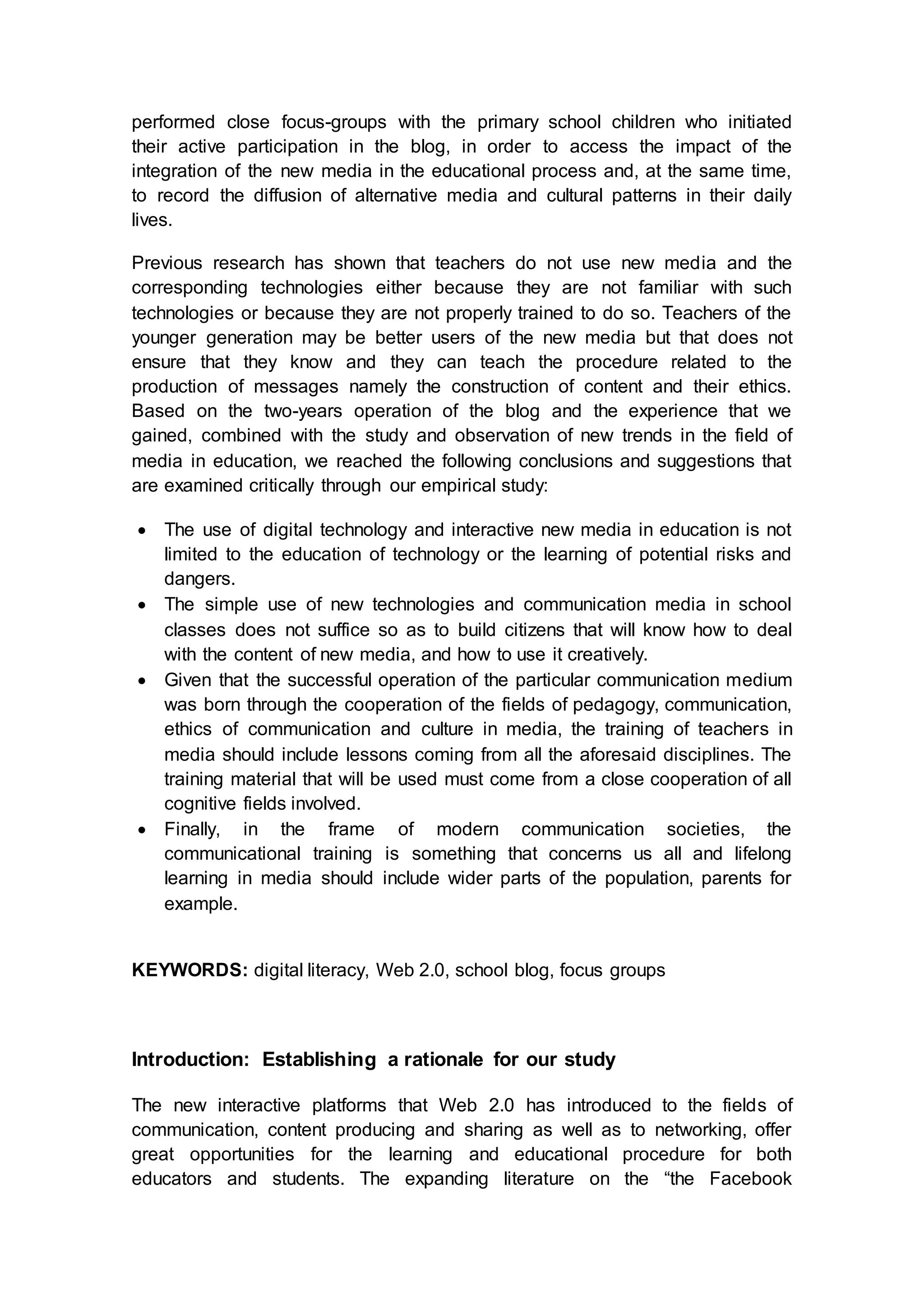
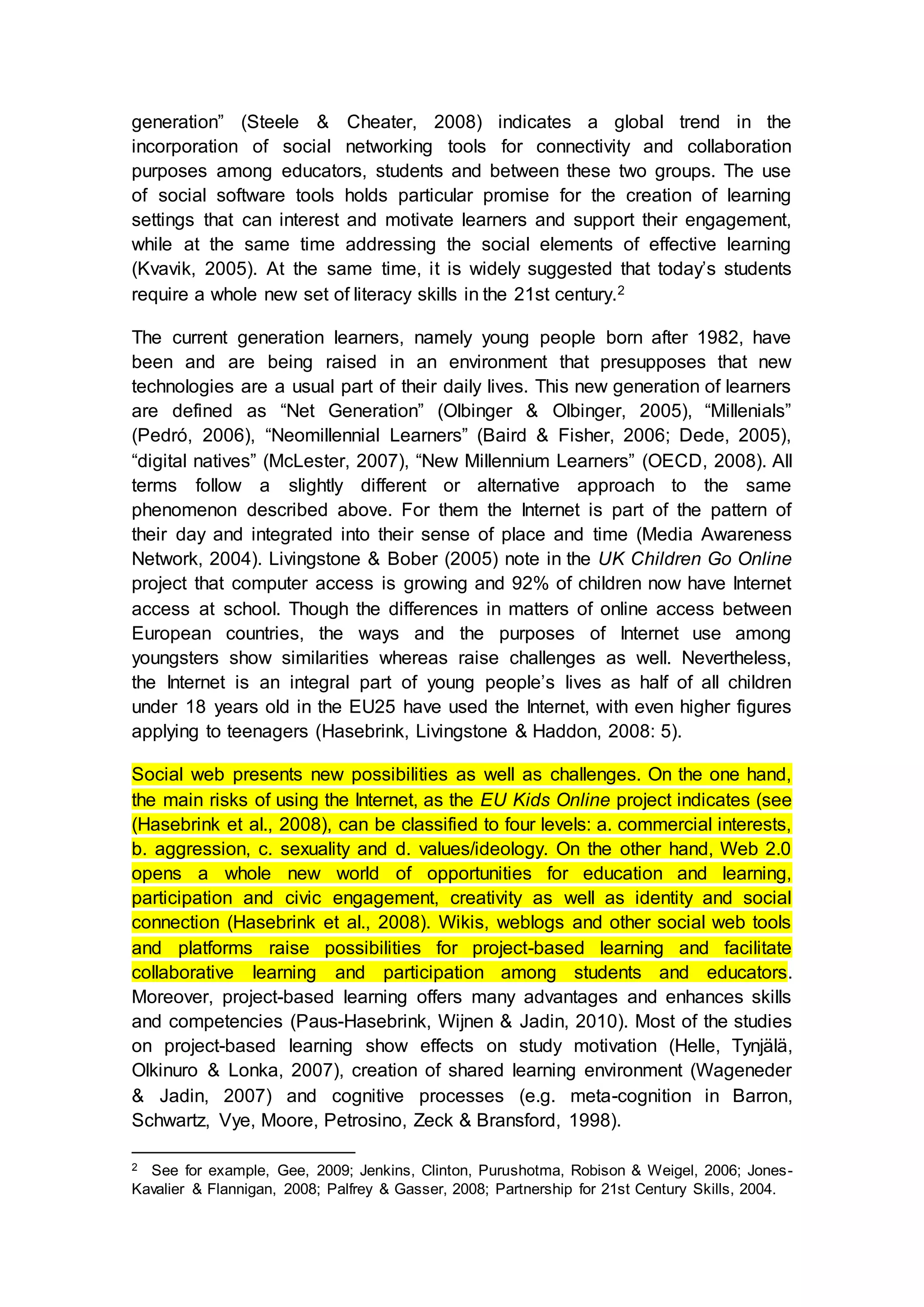

![In its iLANDS dimensions,
Learning 2.0 builds on the
synergy and convergence
among technological,
organizational and
pedagogical innovations4 to
empower the learner
focusing on three major
dimensions: technological,
organization and
pedagogical innovation (see
figure 2).
Figure 2: Indicating the synergy & convergence among the innovations (Redecker et al., 2009:
44).
The changes that we are experiencing through the development and innovation
that Web 2.0 introduces are framed by the participatory culture that we live in.
Participatory culture is the one with
a. relatively low barriers to artistic expression and civic engagement, b.
strong support for creating and sharing one’s creations with others, c.
some type of informal mentorship whereby what is known by the most
experienced is passed along to novices and a culture where its
members believe that their contributions matter and feel some degree of
social connection with one another (Jenkins with Clinton, Purushotma,
Robison & Weigel, 2006: 7).
The four forms of participatory culture, affiliations, expressions, collaborative
problem-solving, and circulations, require “new literacies… [that] involve social
skills developed through collaboration and networking” (Jenkins et. al., 2009: 4).
In this environment with new opportunities and new challenges, it is inevitable
that new skills are also required, namely: play, performance, simulation,
4 See European Commission, 2008.](https://image.slidesharecdn.com/2011eukidsonllne2fullpaperproetoimassiagiaekdossi-120327035101-phpapp01/75/2011-eukids-on-llne-2-full-paper-proetoimassia-gia-ekdossi-5-2048.jpg)
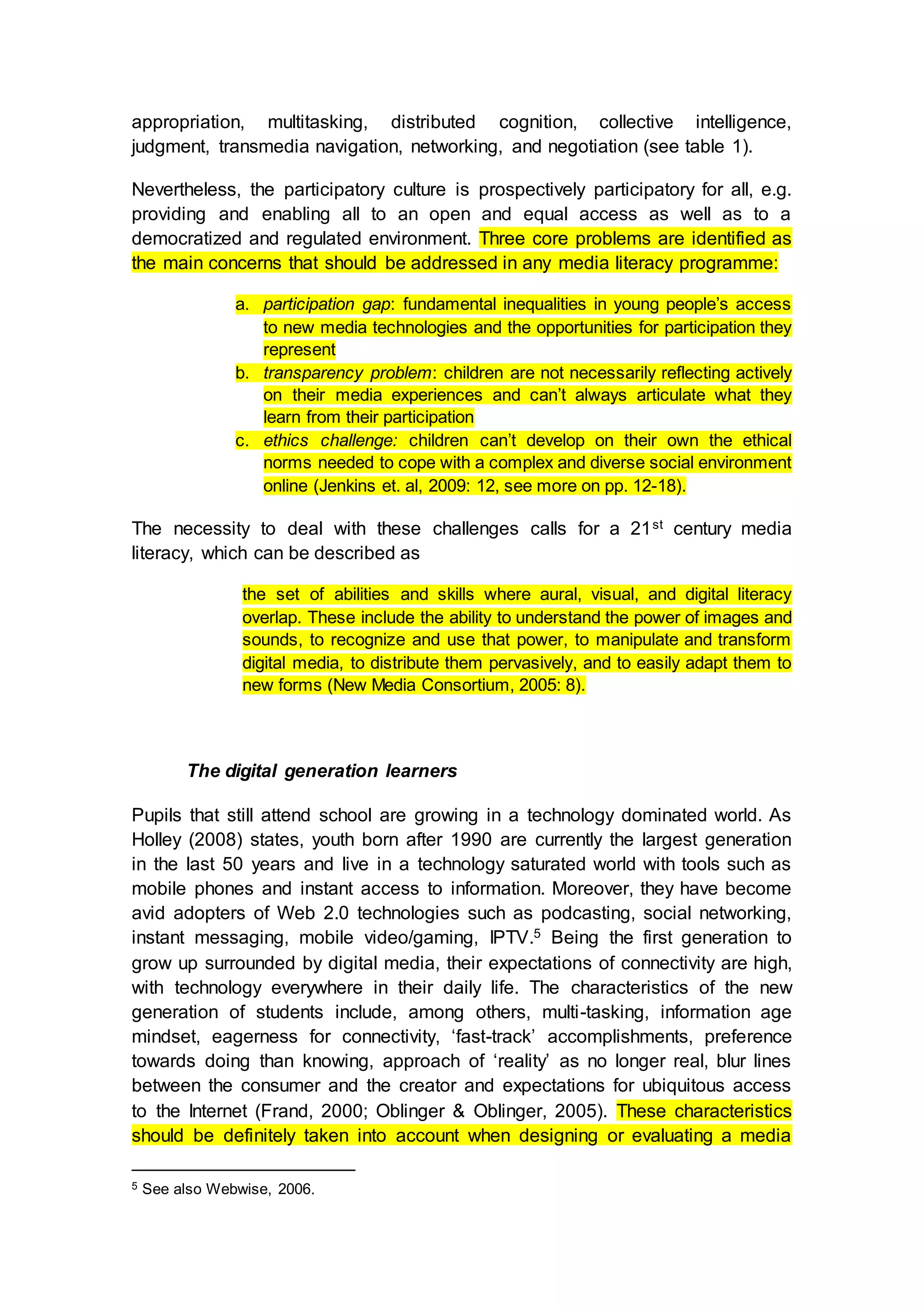
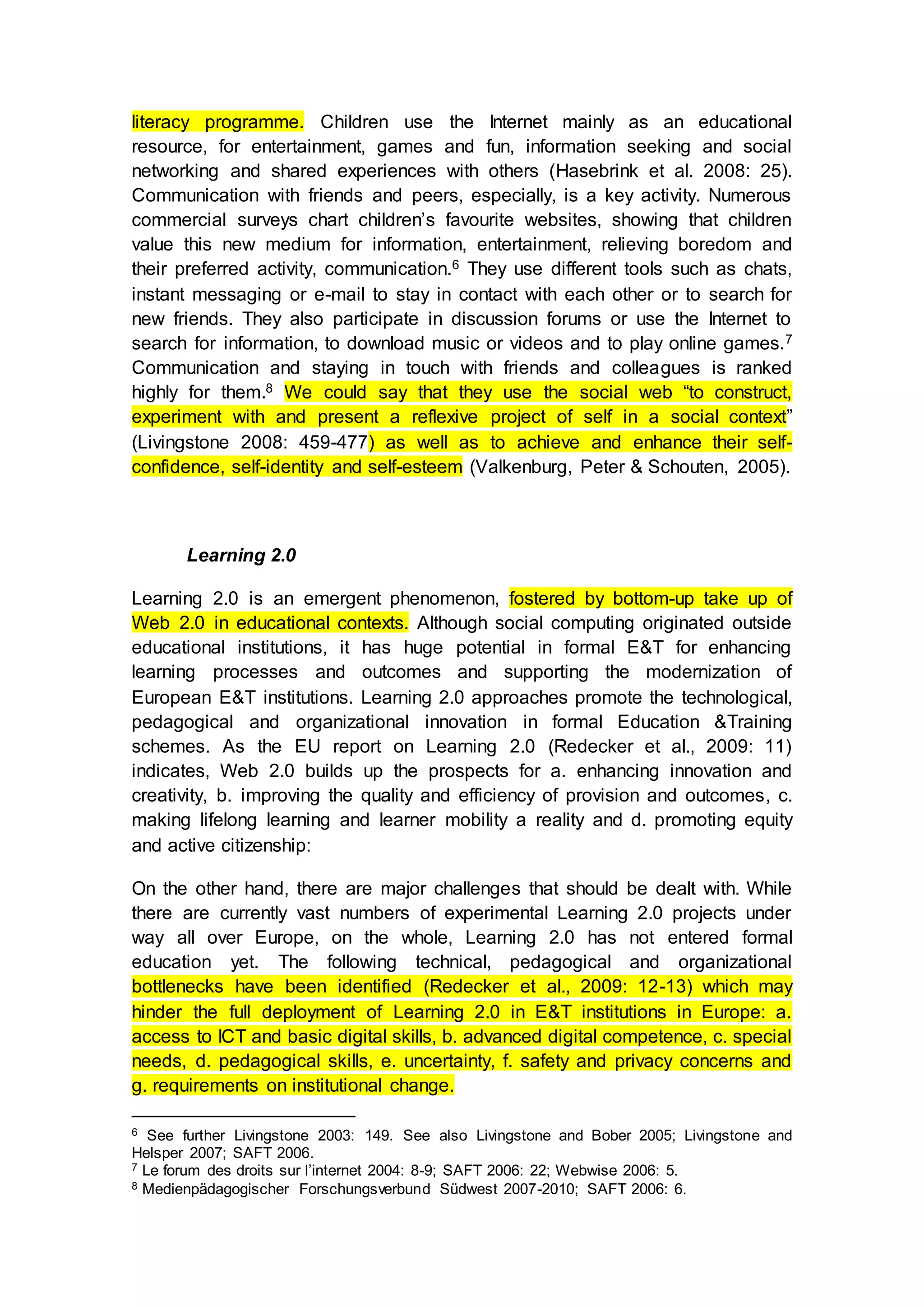
![The foundations of our case study
Our study is based on the specific case study of the monitoring of the two-yearly
operation (school years 2008-2009 and 2009-2010) of the school blog
[ferentes.blogspot.com] that was run collaboratively by Dimitris Korkoriadis, the
teacher of the 3rd (and later 4th in the consequent year) grade in the elementary
Experimental School,9 his pupils and their parents. The blog was more like an
experiment in order to see if this social medium would give him the chance to
improve –and to what degree- his communication with the pupils of 3rd grade
but also with their parents. What is also worth noticing is the fact that the
progress and the process of the project have been mostly experiential.10
The blog did not exclusively deal with school issues. It was full with information
about things that an 8-9 year old child would probably like: quality music, art
and interactive games etc. In addition, the educative posts aimed at giving a
different view of the lesson in relation to the way it was presented by the school
book or at enriching the lesson with additional information. As time went by,
children of the class started to explore new worlds, worlds from the past, the
present and the future, they started to comprehend the difference between
Sakis Rouvas, Lady Gaga and Madonna from one side and Manos Hatzidakis,
Louis Armstrong from the other side. Sometimes, children of the class were
spending all afternoon playing or discovering new posts on the blog. The
parents from the other side, took a trip to memory lane as we listened again to
All you need is love by Beatles as well as to an updated, universal version of
Stand by me. The whole project felt like a spontaneous and unscheduled group
therapy aiming at improving the class community through art.
After observing the intense interest of pupils and parents for the class’ blog as
well as a certain change in their behaviour regarding their amusement habits, it
was realized that the blog with the specific content could be a valuable tool of
9 The Experimental School of the University of Thessaloniki is a special public school, in close
ties with the Aristotle University of Thessaloniki. The University Committee appoints a School
Supervisor, who is, in general, a professor of Pedagogical Studies in the Department of
Philosophy of the University (information available at http://piramatiko.web.auth.gr/init_en.htm,
last accessed 28/4/2011).
10 The leading author of the present paper, Prof. Elsa Deliyanni has participated in Dimitris’ idea
firstly as her daughter was a pupil at the 3rd grade of the Experimental School of the University
of Thessaloniki and has shown personal interest in the project. One day at the late September
of 2008, her daughter asked for a Google email address so that both of them could upload
posts in the blog that has been made by her teacher. The school blog project coincided with her
academic interests during that period as she was supervising the post-graduate thesis of a
Thessaloniki blogger under the title “Legal issues, morals and ethics in blogs and in the Citizen
Journalism” and was also teaching a similar course at the undergraduate course of the
Department of Journalism and Mass Media of the Aristotle University of Thessaloniki. It should
also be noted that the co-author of the present paper, Dr. Dimitrakopoulou got involved in the
project at the recent evaluation stage of the blog.](https://image.slidesharecdn.com/2011eukidsonllne2fullpaperproetoimassiagiaekdossi-120327035101-phpapp01/75/2011-eukids-on-llne-2-full-paper-proetoimassia-gia-ekdossi-8-2048.jpg)
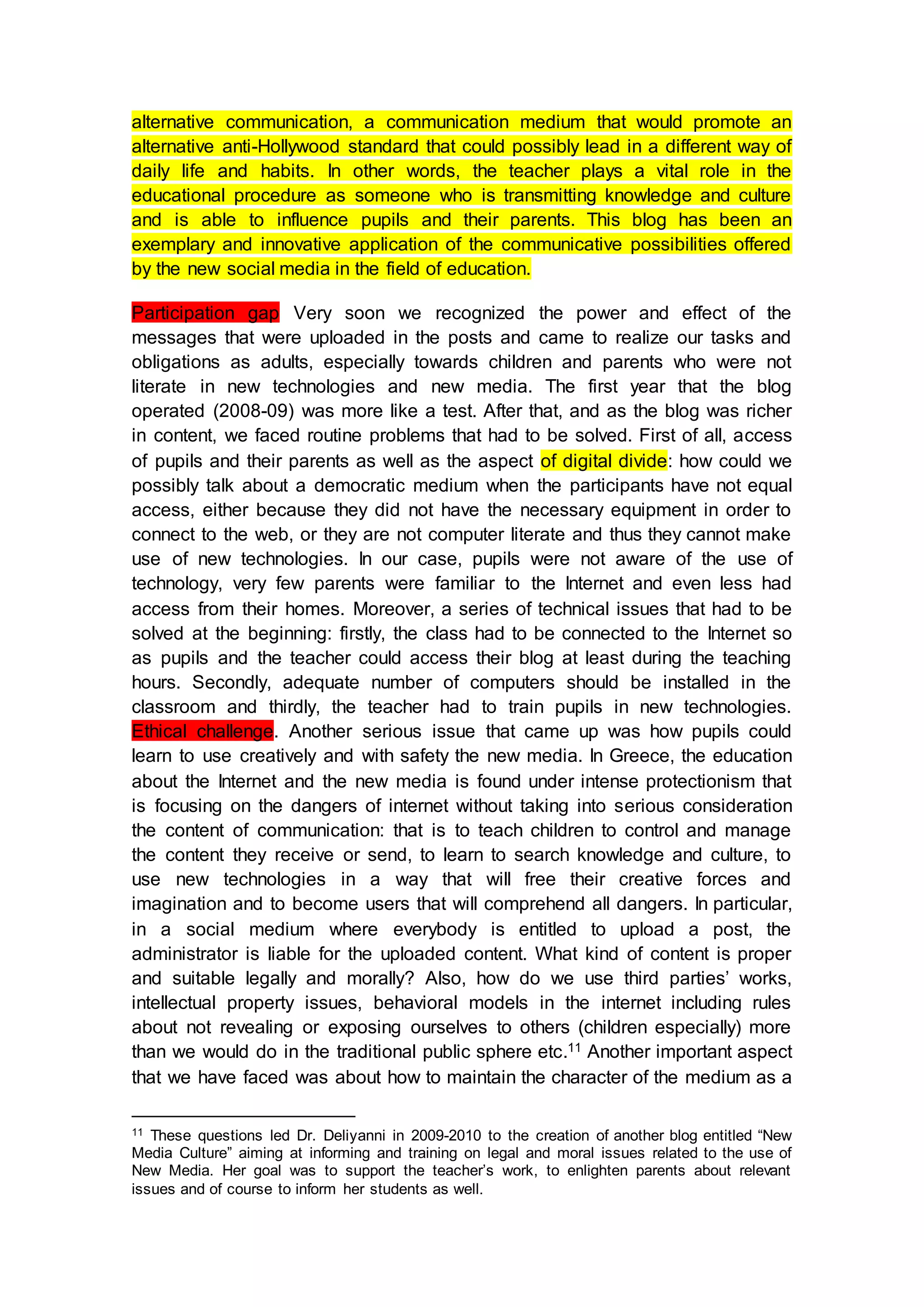
![medium that is producing and diffusing anti-Hollywood models, when 25 pupils
and their parents are entitled to upload posts without censoring the content and
without violating anyone’s right to freely upload the content he/ she wishes.
Evaluation of the blog & feedback by pupils
This summer (June 2011) we decided to proceed to the implementation of an
evaluation process, combining methods based on the specific case under study.
We decided to start first12 with conducting focus groups with the primary school
children who initiated their active participation in the blog, in order to access the
impact of the integration of the new media in the educational process and, at
the same time, to record the diffusion of alternative media and cultural patterns
in their daily lives.13 We decided to conduct all focus groups in a particular day
so that all children shared the feeling of participating in the same thing without
creating any feelings of exclusion and being left out from something that ‘the
other kids are doing’. Before the implementation of our research we had to ask
permission from the Director and the Academic Supervisor of the school14 as
well as from the parents of the children. In the case of the parents, we sent
them a detailed information letter about our research accompanied by a consent
form that they return filled in and signed to the researchers. This way we
reassured that they all understood the nature and the purposes of the research
project and they were reassured that their personal data are anonymous and
confidential – however, they can refuse any question or withdraw at any time
From the 25 children of the particular class we formed five focus groups (five
pupils in each group).15 The pupils were divided into groups by their teacher -in
that year- Mrs Katerina Theodoraki who was asked by the researchers to form
the groups taking into consideration the need for a balanced number of boys
and girls in each group as well as issues of computer literacy and technology
12 Our research in progress will be enriched with the results from the questionnaires addressed
to the parents whose children participated in the school blog as well as with interviews made
with the school teachers.
13 A deficit in our study is that it was conducted one year after the blog ceased its operation, a
problem that we had to take into account when designing the questionnaires and interview
guides with the children and their parents. On the one hand, we are aware that we miss the
spontaneity of the actual use and experiential experience of the blog as well as the actual
memories that could possibly fade away. On the other hand, we benefited from the recording of
a more holistic experience of the overall programme as it was evaluated from a distance
through more mature emotions and other in- and out of school experiences.
14 As we mentioned earlier, the Experimental School is supervised by the Aristotle University of
Thessaloniki that had to provide us with permission to conduct the research in the pupils and in
the school’s premises. As the Experimental Schools regulate under special conditions under the
University’s supervision, we didn’t have to ask for permission from the Ministry of Education.
15 The research team followed in its preparation and the implementation of the project the Best
Practice Guide of the EU Kids Online Project available at
http://www2.lse.ac.uk/media@lse/research/EUKidsOnline/BestPracticeGuide/Home.aspx [last
accessed 12/7/2011].](https://image.slidesharecdn.com/2011eukidsonllne2fullpaperproetoimassiagiaekdossi-120327035101-phpapp01/75/2011-eukids-on-llne-2-full-paper-proetoimassia-gia-ekdossi-10-2048.jpg)
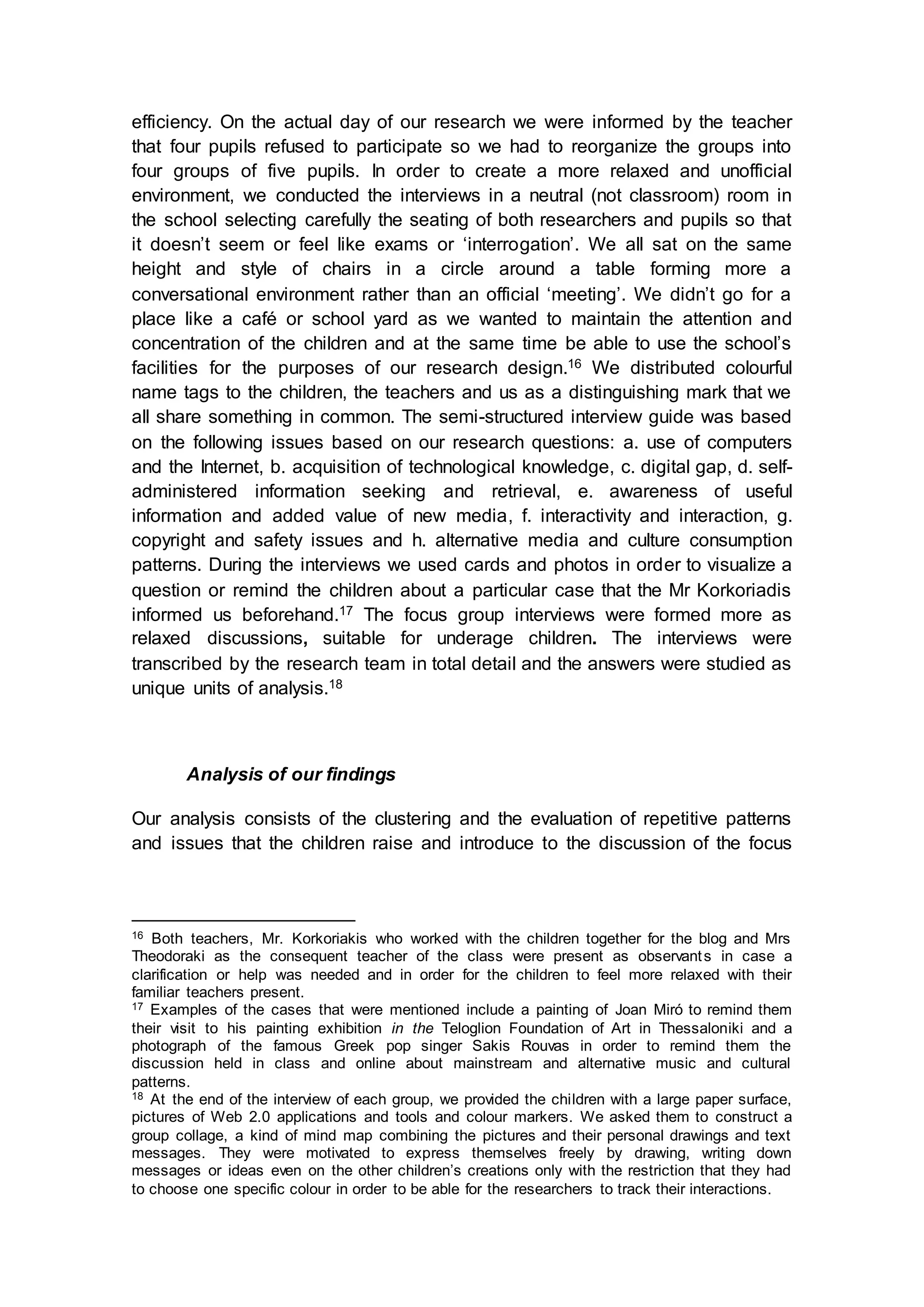
![groups.19 Following the dynamics of the discussions and based on our project
topics, we analyze in the following section our findings and results.20 Particular
parts of the discussions around certain topics are highlighted, leaving others for
future research in combination also with our broader study.
Use of computers & acquisition of technological knowledge
On our first issue regarding the use of computers and the Internet, the vast
majority of the children (19 out of 20) responded that they own a PC at home.
Though it became apparent through clarifying questions that they actually use
their parents’ or siblings’ computer, it is important that they find themselves in
the position to be able to characterize a PC as ‘their own’ showing this way the
frequency and the amount of computer use at home. The PC was mentioned as
the only means to enter the online world (and not mobile devices for example).
The main sources for the acquisition of technological knowledge are parents
and the school teachers. The gender gap in technological matters is evident in
the children’s responses, as the father is mentioned as the dominant figure that
is able to teach them how to use the computer and enter the Internet whereas
helping in frequent troubleshooting while being online. However, in the case of
inexpert parents, the help of other members of the family, as older siblings,
proves to be of greater significance to the younger ones in case of need. The
teacher of the class is also contributing to a great extend to the technological
knowledge of the pupils, especially during the Flexible Zone21 of the school
timetable.
It is worth mentioning that expertise is not attributed to official learning or
acquisition of technical skills: it is more linked to learning by doing and by trial,
indicating a tendency of young children to deal with computers and the Internet
in an informal, freely and spontaneous way imitating a game and not formal
knowledge.
Autonomous online search
19 It should be noted that the results of our findings are grounded on the children’s replies and
their perceptions and not on the actual facts. Our interest at this point is to record the pupils’
own understanding and evaluation of the issues under study. A further analysis and cross-check
with the teacher and the parents will follow at a later stage of our research.
20 See Annex for quotes from the focus groups in relation to our research findings.
21 The Flexible Zone Teaching is based on investigative and participatory methodologies that
maximize the use of cross-thematic concepts in order to promote a cross-thematic and holistic
approach to learning. The following pedagogic initiatives are promoted: a. increased degrees of
freedom to the class teacher, b. greater involvement and active participation of students in the
planning and execution of their own learning and c. promotion and connection of school
knowledge with language, arithmetic and social literacy skills (for more on the Flexible Zone,
visit the site of the Pedagogical Institute of the Ministry of Education, Lifelong Learning and
Religious Affairs at http://www.pi-schools.gr/content/index.php?lesson_id=1000 [last accessed
2/9/2011].](https://image.slidesharecdn.com/2011eukidsonllne2fullpaperproetoimassiagiaekdossi-120327035101-phpapp01/75/2011-eukids-on-llne-2-full-paper-proetoimassia-gia-ekdossi-12-2048.jpg)
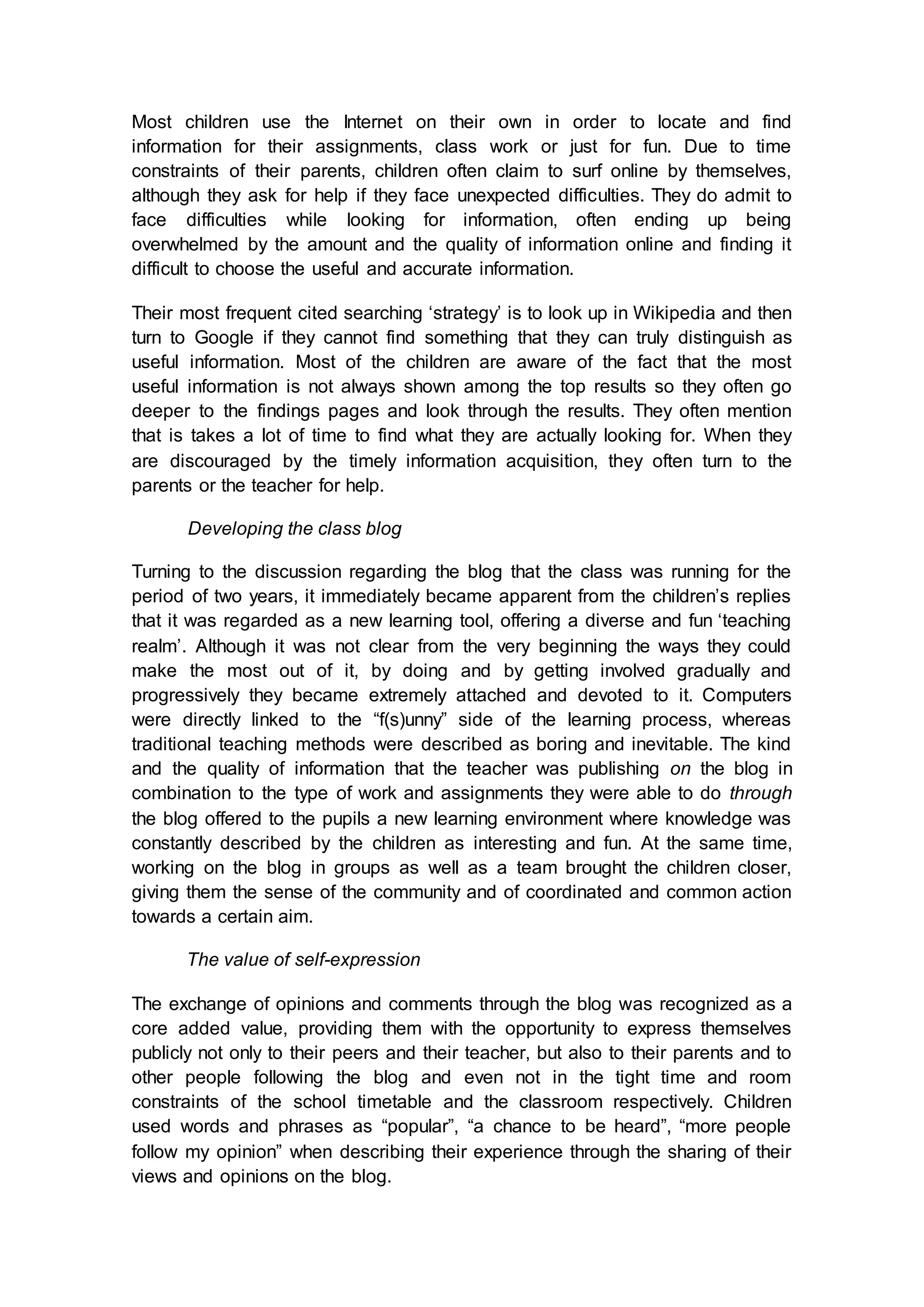
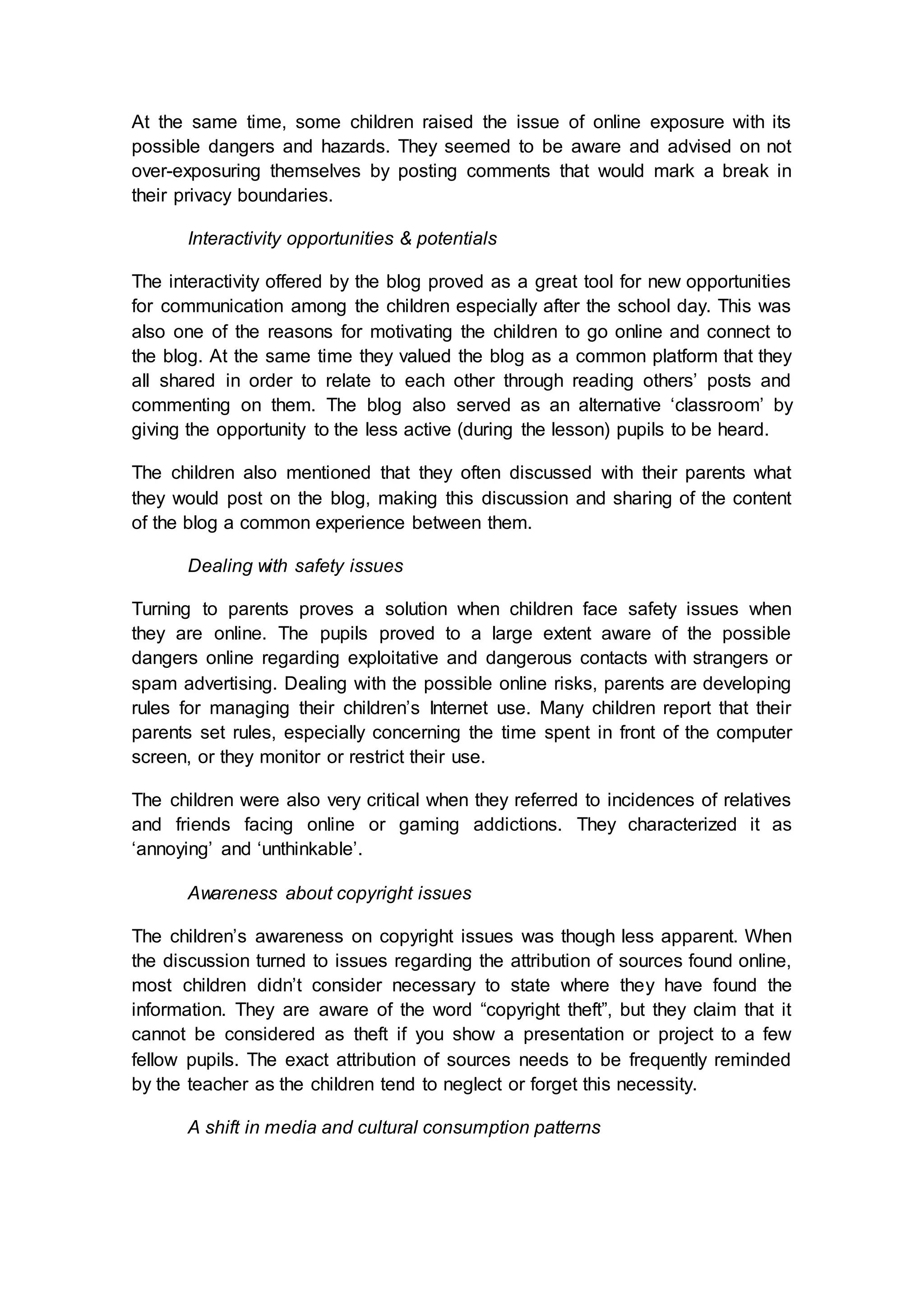
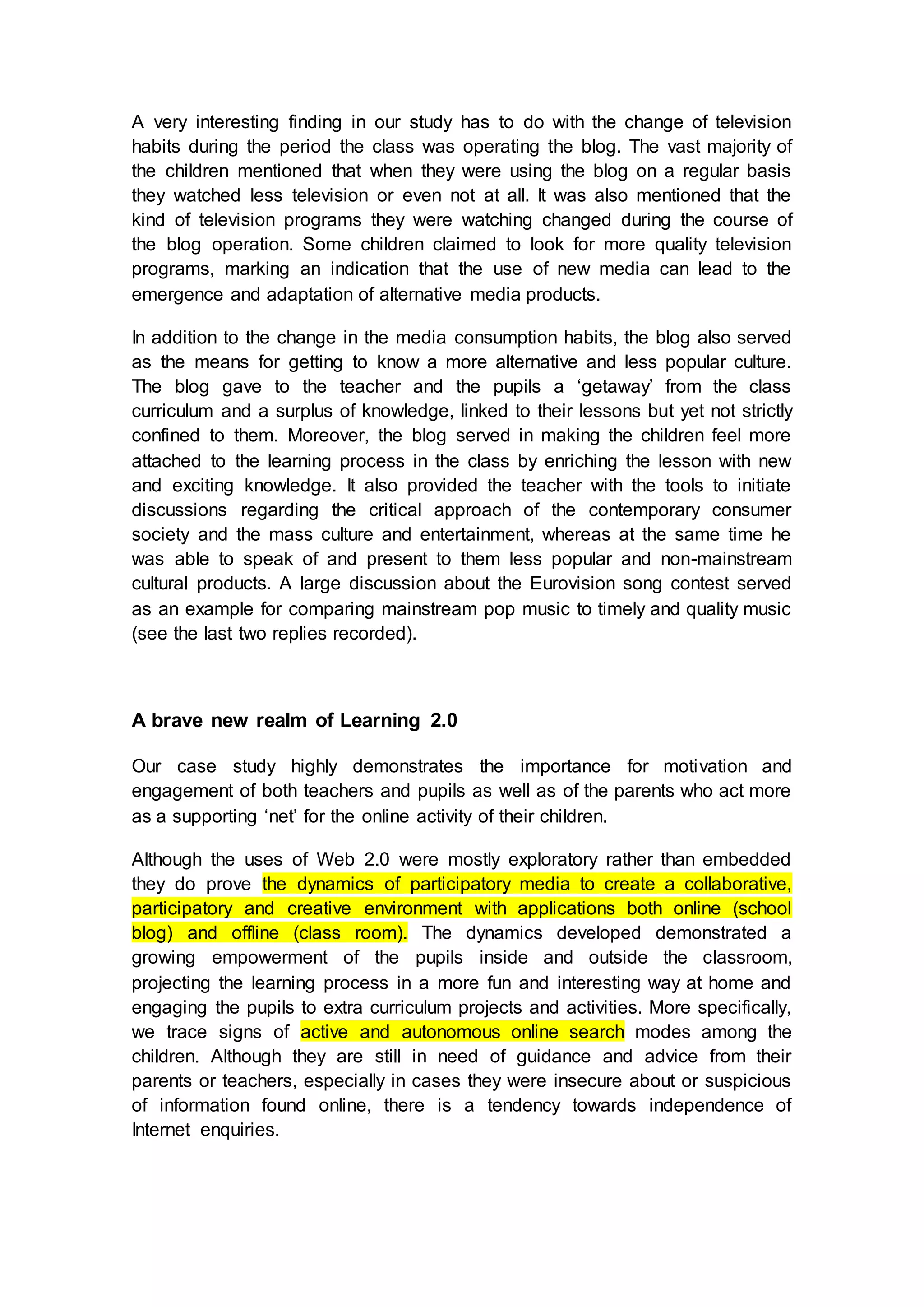
![More evident in our case study is the engagement in collaborative learning
activities among the pupils. Web 2.0 tools are ideal for supporting such
collaboration schemes. However, they are not sufficient for the motivation and
commitment of pupils; the character, the personality and the personal
engagement of the teacher are of major importance for organizing and
stimulating learner-oriented activities extended also beyond the lesson based
on interactivity and interaction and facilitated through the social Internet. Web
2.0 platforms offer also a new kind of engagement with new media literacies
that outline required skills for the young generation and aim towards a more
student-centered pedagogy. Nevertheless, they have the potential to give rise to
new areas for innovation in learning (iLANDS), starting from Learning and
Achieving, going through Networking and embracing Diversity and resulting to
opening up to Society.22 The posting of content was enthusiastically welcomed
by the pupils, who felt that they were doing something important. Sharing and
publishing their thoughts in a written word was highlighted as a major factor for
enhancing their sense of engagement towards a collaborative activity, value of
their peers’ assessment and awareness of a possible larger audience outside
the classroom. The blog platform proved as the most common and user-friendly
publication outlet, through publication of presentations prepared for the lessons,
engaging in online learning games and activities, building personal weblogs and
uploading photographs and images.
The two-year operation of the blog as well as the rich experience we gained,
combined with the study and observation of new trends in the field of media in
education, have led us to certain conclusions and suggestions. First of all, the
use of digital technology and interactive new media in education is not limited to
the education of technology or the learning of potential risks and dangers. The
simple use of new technologies and communication media in school classes
does not suffice so as to make citizens that will know how to deal with the
content of new media, and how to use it creatively23. Moreover, as shown in
past researches,24 teachers in the Greek schools do not use new media and the
corresponding technologies either because they are not familiar with such
technologies or because they are not properly trained to do so. Teachers of the
younger generation may be good users of mass media but that does not ensure
that they know and they can teach the procedure related to the production of
messages namely the construction of content and their ethics.25 However, it
22 See for more on the iLANDS approach in Redecher et. al., 2009.
23 See on the matter, EU Commission Recommendation on media literacy in the digital
environment for a more competitive audiovisual and content industry and an inclusive
knowledge society, available at
http://ec.europa.eu/culture/media/literacy/docs/recom/c_2009_6464_en.pdf, last accessed
2/7/2011].
24 See for example Marantos, 1999.
25 Committee on Culture and Education, Rapporteur: Christa Prets, available at
http://www.europarl.europa.eu/sides/getDoc.do?pubRef=-//EP//TEXT+REPORT+A6-2008-](https://image.slidesharecdn.com/2011eukidsonllne2fullpaperproetoimassiagiaekdossi-120327035101-phpapp01/75/2011-eukids-on-llne-2-full-paper-proetoimassia-gia-ekdossi-16-2048.jpg)
![should be noted that new literacies are linked to an interdisciplinary approach of
teaching, namely pedagogy, communication, ethics of communication and
culture in media. Therefore, the training of teachers in media should include
lessons coming from all the aforesaid disciplines. It is essential that the training
material that will be used must come from a close cooperation of all cognitive
fields involved.
BIBLIOGRAPHY
Baird, D. E. & Fisher, M. (2006). Neomillennial User Experience Design
Strategies: Utilizing Social Networking Media to Support 'Always On'
Learning Styles. Journal of Educational Technology Systems, 34, 5-32.
Barron, B. J. S., Schwartz, D. L., Vye, N. J., Moore, A., Petrosino, A., Zeck, L. &
Bransford, J. D. (1998). Doing with Understanding: Lessons from research
on problem- and project-based learning. The Journal of the Learning
Sciences, 7, 271-311.
Commission of the European Communities. Recommendation on media literacy
in the digital environment for a more competitive audiovisual and content
industry and an inclusive knowledge society, C(2009) 6464 final. Retrieved
from
http://ec.europa.eu/culture/media/literacy/docs/recom/c_2009_6464_en.pd
f.
Dede, C. (2005). Planning for Neomillennial Learning Styles. Educause
Quarterly, 28 (1), 7-12. Retrieved from
http://www.educause.edu/pub/eq/eqm05/eqm0511.asp.
European Commission (2008). Commission Staff Working Document. The use
of ICT to support innovation and lifelong learning for all - A report on
progress, SEC (2008) 2629 final. Retrieved from
http://ec.europa.eu/education/lifelong-learning-
programme/doc/sec2629.pdf.
Frand, J. L. (2000). The Information-Age Mindset: Changes in Students and
Implications for Higher Education. EDUCAUSE Review
(September/October Issue). Retrieved from
http://net.educause.edu/ir/library/pdf/ERM0051.pdf.
Gee, J. P. (2009). Big thinkers: James Paul Gee on grading with games [video].
Edutopia: What Works in Public Education. The George Lucas
Educational Foundation. Retrieved from http://www.edutopia.org/digital-
generation-james-gee-video.
Hasebrink, U., Livingstone, S. & Haddon, L. (2008). Comparing children’s online
opportunities and risks across Europe: cross-national comparisons for EU
Kids Online. Deliverable D3.2. EU Kids Online, London, UK. Retrieved
from http://eprints.lse.ac.uk/21656/1/D3.2_Report-
Cross_national_comparisons.pdf.
Helle, L., Tynjälä, P., Olkinuro, E. & Lonka, K. (2007). ‘Ain‘t Nothin’ Like the
Real Thing.’ Motivation and Study Processes on a Work-Based Project
Course in Information Systems Design’. British Journal of Educational
Psychology, 77, 397-411.
0461+0+DOC+XML+V0//EN [last accessed 2/7/2011] as well as the EU Commission
Recommendation on media literacy (ibid).](https://image.slidesharecdn.com/2011eukidsonllne2fullpaperproetoimassiagiaekdossi-120327035101-phpapp01/75/2011-eukids-on-llne-2-full-paper-proetoimassia-gia-ekdossi-17-2048.jpg)

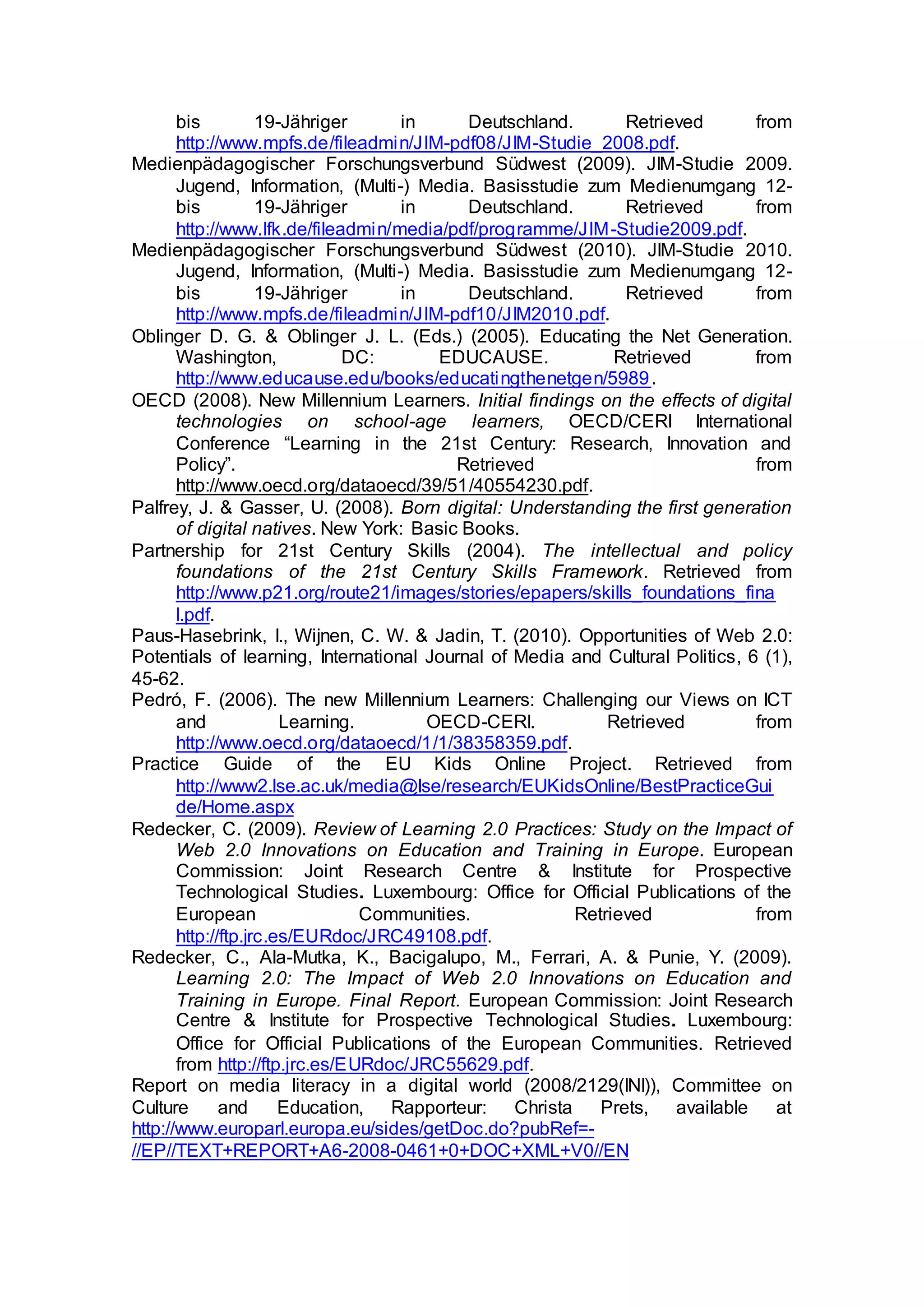

![ANNEX
Analysis of our findings accompanied by representative quotes from the
focus groups
Our analysis consists of the clustering and the evaluation of repetitive patterns
and issues that the children raise and introduce to the discussion of the focus
groups.26 Following the dynamics of the discussions and based on our project
topics, we analyze in the following section our findings and results. Particular
parts of the discussions around certain topics are highlighted, leaving others for
future research in combination also with our broader study.
Use of computers & acquisition of technological knowledge
On our first issue regarding the use of computers and the Internet, the vast
majority of the children (19 out of 20) responded that they own a PC at home.
Though it became apparent through clarifying questions that they actually use
their parents’ or siblings’ computer, it is important that they find themselves in
the position to be able to characterize a PC as ‘their own’ showing this way the
frequency and the amount of computer use at home. The PC was mentioned as
the only means to enter the online world (and not mobile devices for example).
The main sources for the acquisition of technological knowledge are parents
and the school teachers. The gender gap in technological matters is evident in
the children’s responses, as the father is mentioned as the dominant figure that
is able to teach them how to use the computer and enter the Internet whereas
helping in frequent troubleshooting while being online. However, in the case of
inexpert parents, the help of other members of the family, as older siblings,
proves to be of greater significance to the younger ones in case of need. The
teacher of the class is also contributing to a great extend to the technological
knowledge of the pupils, especially during the Flexible Zone27 of the school
timetable.
“My father has taught me how to use the PC and work in Powerpoint since I was 7-8
and has shown me how to access the Internet or what to do if I can’t get online”.
26 It should be noted that the results of our findings are grounded on the children’s replies and
their perceptions and not on the actual facts. Our interest at this point is to record the pupils’
own understanding and evaluation of the issues under study. A further analysis and cross-check
with the teacher and the parents will follow at a later stage of our research.
27 The Flexible Zone Teaching is based on investigative and participatory methodologies that
maximize the use of cross-thematic concepts in order to promote a cross-thematic and holistic
approach to learning. The following pedagogic initiatives are promoted: a. increased degrees of
freedom to the class teacher, b. greater involvement and active participation of students in the
planning and execution of their own learning and c. promotion and connection of school
knowledge with language, arithmetic and social literacy skills (for more on the Flexible Zone,
visit the site of the Pedagogical Institute of the Ministry of Education, Lifelong Learning and
Religious Affairs at http://www.pi-schools.gr/content/index.php?lesson_id=1000 [last accessed
2/9/2011].](https://image.slidesharecdn.com/2011eukidsonllne2fullpaperproetoimassiagiaekdossi-120327035101-phpapp01/75/2011-eukids-on-llne-2-full-paper-proetoimassia-gia-ekdossi-21-2048.jpg)
![“I learnt most of the stuff in the computer classes and sometimes my brother helps me”.
“My mum is an engineer and she has taught me since I was very young to work on the
computer, but I have learned better with my teachers”.
“[I was taught] by my father but also by my teachers at school”.
“[I was taught] by my father. Mum doesn’t have a clue!”
“Mine neither! She doesn’t even know where ‘backspace’ is!”
It is worth mentioning that expertise is not attributed to official learning or
acquisition of technical skills: it is more linked to learning by doing and by trial,
indicating a tendency of young children to deal with computers and the Internet
in an informal, freely and spontaneous way imitating a game and not formal
knowledge.
“I heard of people talking about the Internet and I wanted also to learn and do, to see
how it is”.
“Since I was little I played [computer] games with my dad and I started learning and
started visiting other sites and games [...]”
“[Our teacher] taught us a few things about Powerpoint and then I was searching and
finding on my own”.
“We are used to a few pages. When a friend shows us another one, we may go there
as well”.
Autonomous online search
Most children use the Internet on their own in order to locate and find
information for their assignments, class work or just for fun. Due to time
constraints of their parents, children often claim to surf online by themselves,
although they ask for help if they face unexpected difficulties. They do admit to
face difficulties while looking for information, often ending up being
overwhelmed by the amount and the quality of information online and finding it
difficult to choose the useful and accurate information.
“I mostly search by myself and if I can’t find on my own a lot of information I ask help
from my sister, if she has the time and she is willing to help”.
“Sometimes it is difficult, according to what you are looking for, and sometimes it is
easy”.
“Most of the times it is easy… but I remember that once I was looking for something
[…] there were a lot of pages and I couldn’t find what I wanted…and I didn’t know what
to do”.](https://image.slidesharecdn.com/2011eukidsonllne2fullpaperproetoimassiagiaekdossi-120327035101-phpapp01/75/2011-eukids-on-llne-2-full-paper-proetoimassia-gia-ekdossi-22-2048.jpg)
![“Most of the times there are no specific results and I have to search for long time”.
“I do too get online to find information and stuff and I end up with irrelevant things”.
Their most frequent cited searching ‘strategy’ is to look up in Wikipedia and then
turn to Google if they cannot find something that they can truly distinguish as
useful information. Most of the children are aware of the fact that the most
useful information is not always shown among the top results so they often go
deeper to the findings pages and look through the results. They often mention
that is takes a lot of time to find what they are actually looking for. When they
are discouraged by the timely information acquisition, they often turn to the
parents or the teacher for help.
“When I am bored, my mom is searching and does it fast”.
“I ask for help only when I can’t get online and I can’t fix it by myself”.
“If you can’t find at once what you are looking for you can change the letters or the
page you are in, namely you will go to the second page of the results”.
“We keep looking because there could be another better [webpage]”.
Developing the class blog
Turning to the discussion regarding the blog that the class was running for the
period of two years, it immediately became apparent from the children’s replies
that it was regarded as a new learning tool, offering a diverse and fun ‘teaching
realm’. Although it was not clear from the very beginning the ways they could
make the most out of it, by doing and by getting involved gradually and
progressively they became extremely attached and devoted to it. Computers
were directly linked to the “f(s)unny” side of the learning process, whereas
traditional teaching methods were described as boring and inevitable. The kind
and the quality of information that the teacher was publishing on the blog in
combination to the type of work and assignments they were able to do through
the blog offered to the pupils a new learning environment where knowledge was
constantly described by the children as interesting and fun. At the same time,
working on the blog in groups as well as a team brought the children closer,
giving them the sense of the community and of coordinated and common action
towards a certain aim.
“The lesson was nicer, it was fun!”
“We sometimes stayed in the class during the break, we wanted to continue!”
“When we worked with the computers the first time, it was like a baby goes to
Kindergarten […] We did it [the blog] the first day, we said ‘Great, we are missing the
lesson!’… the second time we said the same… huh, the third time we understood that
this was our new lesson!”](https://image.slidesharecdn.com/2011eukidsonllne2fullpaperproetoimassiagiaekdossi-120327035101-phpapp01/75/2011-eukids-on-llne-2-full-paper-proetoimassia-gia-ekdossi-23-2048.jpg)
![“I like the lesson better with the blog […]. It became more interesting”.
“We dealt with the computer, but we also learned things thanks to the computer”.
“We did something more interesting, we weren’t just sitting and having lessons…”.
“The whole class was uploading things. We did something in the computer all
together”.
“I like it very much because maybe it [the blog] was what taught me to use the
computer and it was so much fun... beacuse everyone was telling his opinion, everyone
was describing something that happened. Others out from school, out of the class were
visiting it and they were seeing what we were doing and we had a lot of fun!”.
The value of self-expression
The exchange of opinions and comments through the blog was recognized as a
core added value, providing them with the opportunity to express themselves
publicly not only to their peers and their teacher, but also to their parents and to
other people following the blog and even not in the tight time and room
constraints of the school timetable and the classroom respectively. Children
used words and phrases as “popular”, “a chance to be heard”, “more people
follow my opinion” when describing their experience through the sharing of their
views and opinions on the blog.
“I felt that I was expressing my thoughts in the blog. And I liked it…it pleased me”.
“It was nice because you usually say your opinion and they barely listen to you…
whereas when you write something, someone will wonder to see what you wrote and
everyone knows what you are writing, they know your opinion”.
“I felt somehow popular, if I may say it? […] To be able to communication with the
others”.
“[I felt] happy, as I am also a member of the blog community”.
At the same time, some children raised the issue of online exposure with its
possible dangers and hazards. They seemed to be aware and advised on not
over-exposuring themselves by posting comments that would mark a break in
their privacy boundaries.
“You always have to keep some distances because you are not the only one who sees
that blog […] anyone can see it and you have to be careful with your words […] you
shouldn’t write whatever comes into your head”.
“It’s nice [to post online] but you have to be careful with what you say and write […] you
shouldn’t post addresses, names, because a crazy person may see it”.
Interactivity opportunities & potentials](https://image.slidesharecdn.com/2011eukidsonllne2fullpaperproetoimassiagiaekdossi-120327035101-phpapp01/75/2011-eukids-on-llne-2-full-paper-proetoimassia-gia-ekdossi-24-2048.jpg)
![The interactivity offered by the blog proved as a great tool for new opportunities
for communication among the children especially after the school day. This was
also one of the reasons for motivating the children to go online and connect to
the blog. At the same time they valued the blog as a common platform that they
all shared in order to relate to each other through reading others’ posts and
commenting on them. The blog also served as an alternative ‘classroom’ by
giving the opportunity to the less active (during the lesson) pupils to be heard.
“I liked it because we could also speak, express ourselves through the blog”.
“Sometimes we don’t have much time [in the class] and we don’t always raise our
hand”.
“At home we have as much time as we want [to write our opinion], whereas in the class
we have less time and you have to speak fast”.
“[I feel different when I say something in the class. I raise my hand and I will be heard
only by the ones who are there. On the contrary, if you write it on the blog, others
outside the class can see, read it too”.
“When I was posting something, I was eager the next day to see the comment that
someone would make on mine”.
The children also mentioned that they often discussed with their parents what
they would post on the blog, making this discussion and sharing of the content
of the blog a common experience between them.
“I discussed it sometimes. I said ‘dad, mom, I am going to post this’ and so I did”.
“Sometimes we asked them what to post if we didn’t any ideas”.
Dealing with safety issues
Turning to parents proves a solution when children face safety issues when
they are online. The pupils proved to a large extent aware of the possible
dangers online regarding exploitative and dangerous contacts with strangers or
spam advertising. Dealing with the possible online risks, parents are developing
rules for managing their children’s Internet use. Many children report that their
parents set rules, especially concerning the time spent in front of the computer
screen, or they monitor or restrict their use.
“I report it to my mom and she tells me to shut it down when I see something weird”.
“I tell it to my mom and she sees it too and advices me what to do”.
“If I see something very weird, I shut it down. If it is something of medium level, I will tell
it to my mom and we will talk about it”.](https://image.slidesharecdn.com/2011eukidsonllne2fullpaperproetoimassiagiaekdossi-120327035101-phpapp01/75/2011-eukids-on-llne-2-full-paper-proetoimassia-gia-ekdossi-25-2048.jpg)
![“Once I entered some pages that were asking weird things, such as ‘is your house big
or small’ and I am somehow afraid of these things and of course I discuss them with
my parents […] Because I have a lot of such things […] I often call my mom”.
“There are some online advertisments and various messages pop up...’answer this
question and you will win a cellphone’ or ‘you will win 500 euros’...I never played. It
would be right”.
The children were also very critical when they referred to incidences of relatives
and friends facing online or gaming addictions. They characterized it as
‘annoying’ and ‘unthinkable’.
“I am not one of these kids who are computer maniacs and play games and don’t leave
the computer for four hours. I enter the computer when I have to prepare a
presentation or to do something interesting. I know some children who sit even a whole
day in front of the computer…How can they do that? It’s crazy!”
“I think it is a bit scary, I can’t understand how they sit so many hours in front of the
computer”.
Awareness about copyright issues
The children’s awareness on copyright issues was though less apparent. When
the discussion turned to issues regarding the attribution of sources found online,
most children didn’t consider necessary to state where they have found the
information. They are aware of the word “copyright theft”, but they claim that it
cannot be considered as theft if you show a presentation or project to a few
fellow pupils. The exact attribution of sources needs to be frequently reminded
by the teacher as the children tend to neglect or forget this necessity.
“The truth is that if I see a good text, I hurry to get it and post it. And then I use it. I take
out the useless information and keep the useful ones”.
“I sometimes read them and copy-paste them in Word. I don’t have to [write where I got
them from], neither in the photos].
“I don’t write [write where I got them from], because, ok, it won’t be considered a theft if
we show it to a few kids…because most of the texts we find are for assignments…so
we don’t have to”.
“I don’t write it in the presentations because I think it is somehowexcessive… because
it seems to me as advertising… it seems to me as you are interrupting the presentation
and say ‘stop, let me tell where I got the image from’ and then you continue”.
“Sometimes in our presentations we wrote where we got the material and the images
from. Sometimes, not always”.
“We did it for some time…then it was forgotten”.](https://image.slidesharecdn.com/2011eukidsonllne2fullpaperproetoimassiagiaekdossi-120327035101-phpapp01/75/2011-eukids-on-llne-2-full-paper-proetoimassia-gia-ekdossi-26-2048.jpg)
![A shift in media and cultural consumption patterns
A very interesting finding in our study has to do with the change of television
habits during the period the class was operating the blog. The vast majority of
the children mentioned that when they were using the blog on a regular basis
they watched less television or even not at all. It was also mentioned that the
kind of television programs they were watching changed during the course of
the blog operation. Some children claimed to look for more quality television
programs, marking an indication that the use of new media can lead to the
emergence and adaptation of alternative media products.
“When the blog stopped operating I even watched more television because I didn’t
have anything to do”.
“The blog gave me ideas for activities, so that instead of watching television, I could do
what I was thinking”.
“I became more eclectic, while I was watching crap things before the blog. As I started
to have an opinion on the Internet about something, I had then also opinion about the
television as well […] I started thinking more”.
“I regarded television as ancient compared to the blog!”
“Television can get boring, while the Internet doesn’t get that boring…the Internet has a
lot of more interesting stuff than the television…”.
In addition to the change in the media consumption habits, the blog also served
as the means for getting to know a more alternative and less popular culture.
The blog gave to the teacher and the pupils a ‘getaway’ from the class
curriculum and a surplus of knowledge, linked to their lessons but yet not strictly
confined to them. Moreover, the blog served in making the children feel more
attached to the learning process in the class by enriching the lesson with new
and exciting knowledge. It also provided the teacher with the tools to initiate
discussions regarding the critical approach of the contemporary consumer
society and the mass culture and entertainment, whereas at the same time he
was able to speak of and present to them less popular and non-mainstream
cultural products. A large discussion about the Eurovision song contest served
as an example for comparing mainstream pop music to timely and quality music
(see the last two replies recorded).
“We learnt a lot of new things...about arts, music, history, maths...This blog was a
source of knowledge!”
“We learned a lot of things that we had never heard of before...”.
“I also believe that I learned more through the blog because it was working as a second
school... whatever you couldn’t learn in the class, you entered the blog and you learned
something more”.](https://image.slidesharecdn.com/2011eukidsonllne2fullpaperproetoimassiagiaekdossi-120327035101-phpapp01/75/2011-eukids-on-llne-2-full-paper-proetoimassia-gia-ekdossi-27-2048.jpg)
